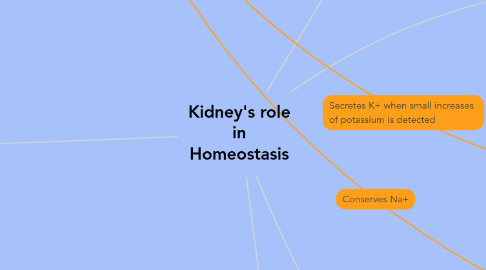
1. 3) Regulation of Blood pH Balance
1.1. Normal pH range: 7.35-7.45
1.2. Bicarbonate buffering system. The lung and kidney are the two main organs that control the acid-base balance of the body
1.2.1. Bicarbonate ion concentration is controlled by the kidneys. Bicarbonate ions are filtered in by the glomerulus. 90% is reabsorbed in the proximal tubule and 10% in the distal tubule.
1.2.1.1. If plasma bicarbonate concentration is higher than normal, excess is excreted out in the urine.
2. 1) Regulates Blood Volume and Osmolality
2.1. Anti-diuretic Hormone (ADH)
2.1.1. ADH secretes from posterior pituitary glands and responds to a rise in plasma osmolarity.
2.1.1.1. Receptors are located in collecting ducts of kidney tubules. Opens water channels when ADH is present allowing the reabsorption of water diluting the plasma thus lowering osmolarity.
2.1.1.2. Sodium and Chloride contribute to 95% of extracellular fluid. Sodium concentration important in determining ADH secretion
2.1.2. Action: Prevents diuresis/water loss; water conserving hormone. Also causes vasoconstricion in high amounts.
2.2. Atrial Natriuretic Peptide
2.2.1. 5 Major effects: - Inhibit aldosterone secretion by the adrenal cortex - Reduce renin release by the kidneys - Reduce ADH release from posterior pituitary - Vasodilation - Natriuresis and diuresis
2.2.2. Action: All effects result in excretion of sodium and water thus reducing body fluid volume back to normal.
2.3. Aldosterone
2.3.1. Effects on the kidney: - Conserve sodium - Water retention - Secrete potassium
2.3.1.1. Aldosterone is the only hormone involved in the control of potassium content.
2.3.2. Action: Effects of aldosterone work to stabilize blood pressure and increase blood voume
3. 2) Regulates Blood Pressure
3.1. Kidneys auto regulate blood pressure entering the glomerular capillaries to maintain GFR.
3.2. Renin is released by the kidneys when blood pressure entering the glomerulus drops.
3.3. Renin has a direct effect on blood pressure through the renin-angiotensin pathway.
3.3.1. Renin-angiotensin-aldosterone Pathway (RAAS): -Renin acts via the RAAS, undergoing through a series of chemical processes in the bod. -Renin is processed into Angiotensin I and then to Angiotensin II.
3.3.1.1. Angiotensin II I acts as a vasodialator which work to increase bloodpressure
3.3.1.2. Angiotensin II also acts on the adrenal glands to secrete the hormone Aldosterone.
3.3.1.2.1. Aldosterone works to increase blood volume and blood pressure
4. 5) Erythropoietin (EPO) Production
4.1. Kidney produces the hormone erythrypoietin(EPO). EPO works on the cells in the bone marrow to produce red blood cells(RBC)
4.1.1. 20% of EPO is produced at extrarenal sites. Extrarenal production of EPO is insuffecient to maintain red blood cell count at normal levels
4.2. EPO production is stimulated by hypoxia
4.2.1. EPO maintains the normal red cell count and prevention of anaemia
5. 4) Regulates Ion Concentration
5.1. Potassium
5.1.1. Main intracellular cation. Maintains the membrane potential of nerve and muscle.
5.1.1.1. Potassium secretion linked to sodium and hydrogen ions
5.1.1.2. Potassium uptake into cells is dependent on the acid-base balance.
5.1.1.2.1. Acidosis (low blood pH) causes release of potassium from cells. Acid-base disturbances must first be corrected
5.1.2. K+: 3.6-5.2 mmol/L
5.1.2.1. Hyperkalaemia (>5.2mmol/L) due to decrease potassium excretion, insulin deficiency, Beta-Blockers, excessive tissue breakdown following trauma.
5.1.2.2. Hypokalaemia (<3.6mmol/L) due to excessive vomiting, diarrhea or use of certain prescribed diuretics.
5.2. Sodium
5.2.1. Main extracellular cation and is linked to extracellular volume
5.2.2. Na+: 136-145mmol/L
5.2.2.1. Increase in body sodium content = increase in extracellular volume leading to hypertension and oedema
5.2.2.2. Decrease body sodium content = decrease in extracellular fluid volume leading to hypotension and dehydration
5.3. Magnesium
5.3.1. Intracellular cation involved in energy storage and production
5.3.1.1. Parathyroid Hormone (PTH) increases tubular re-absorption
5.3.1.2. Most diuretics and alcohol increase MG+ secretion
5.3.2. Mg+: 0.85-1.10 mmol/L
5.4. Calcium
5.4.1. Extracellular ion important for controlling nerve and muscle conduction
5.4.1.1. PTH secretion is stimulated by decrease in plasma calcium concentration, reduce when calcium plasma rises.
5.4.1.1.1. Increase PTH = increase plasma calcium levels
5.4.1.2. PTH converts Vit D to calcitriol. Calcitriol effects causes a rise in plasma calcium levels
5.4.2. Ca: 2.2-2.7 mmol/L
5.5. Phosphate
5.5.1. Important in buffer systems to maintain the plasma pH
5.5.1.1. The presence of PTH reduces the reabsorption of phosphate from the proximal tubule of the kidney;
5.5.1.1.1. Thus increase excretion of phosphate in the urine
5.5.1.2. PTH increases uptake of phosphate in the gut and into the bones
5.5.2. Phosphate: 0.87-1.45 mmol/L
6. Hormone Interaction with the Kidneys
6.1. Parathyroid Hormone (PTH)
6.1.1. PTH is secreted by the parathyroid gland. - Increases reabsorption of magnesium - Increase plasma calcium concentration by increasing bone breakdown -PTH increase phosphate excretion
6.1.2. PTH stimulats a step in the conversion of Vitamin D into Calcitriol
6.2. Renin
6.2.1. The juxtaglomerular complex is the location of renin-releasing cells in the kidney. Renin acts via the renin-angiotensin system (RAAS)
6.3. Erythropoietin (EPO)
6.3.1. Kidney produces approximately 80% of EPO hormone. EPO maintains normal red cell count and is stimulated by hypoxia

